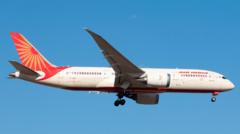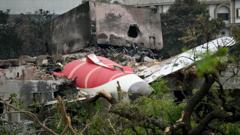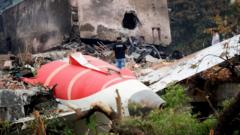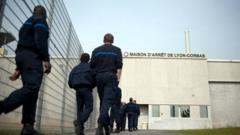### Summary: Air India Flight 171 plunged shortly after takeoff from Ahmedabad, leading investigators to sift through wreckage and voice recorders to determine the cause. Early indicators suggest a focus on engine performance and crew actions, while broader safety implications for Boeing's fleet hang in the balance.
### Title: Investigating the Tragic Air India Flight 171 Crash: A Deep Dive

### Title: Investigating the Tragic Air India Flight 171 Crash: A Deep Dive
### Description: A brief exploration of the ongoing investigation into the Air India Boeing 787 crash, with insights from aviation experts on potential causes and unfolding evidence.
The recent crash of Air India Flight 171, a Boeing 787 that went down shortly after takeoff from Ahmedabad, has prompted a major investigation as experts seek to uncover the causes behind this tragic incident. The aircraft was airborne for less than 40 seconds before descending rapidly into a densely populated area, raising immediate concerns about what went wrong.
According to initial reports, the flight took off at 13:39 local time with 242 individuals aboard and a significant fuel load. Approximately 30 seconds into the flight, a mayday call was made from the cockpit, marking the last communication before the aircraft lost altitude and collided with a hostel nearby. Investigations will focus on various potential factors, including engine failure due to external strikes or fuel contamination, maintenance lapses, or pilot error.
Captain Kishore Chinta, a former investigator with India’s Aircraft Accident Investigation Bureau (AAIB), referred to this incident as an extremely rare controlled flight into terrain shortly after takeoff. As investigators start examining the wreckage, the engines will serve as critical evidence, with their damage patterns indicating whether they were operational at the time of impact.
The aircraft’s "black boxes," which store crucial cockpit audio and flight data, have reportedly been recovered and will be analyzed thoroughly. These recordings will provide insight into pilot communications and critical technical parameters at the moment of the crash.
An essential component of the investigation involves evaluating the performance of the plane’s flaps and slats, which play a vital role in lift generation during takeoff. Investigators should discern from the flight data whether the engines were producing power and whether these components were correctly utilized.
Boeing's advanced flight management control systems will also be closely scrutinized, as any systemic issues could have significant implications for its fleet of 1,100 aircraft operating worldwide. The AAIB will lead the investigation, enlisting experts from organizations such as Boeing, General Electric, and the National Transportation Safety Board (NTSB).
Thus far, no major faults have been attributed to Air India itself, as recent inspections indicated compliance with safety standards for much of its fleet. Investigators are also collecting maintenance histories, pilot records, and any reported technical issues prior to this flight, which are all critical pieces of the puzzle.
As the investigation unfolds, the complexity of modern aviation technology is expected to assist in quickly identifying the cause of this unfortunate event. The increased precision of data recorders that capture hundreds of parameters offers a new level of detail that can expedite the investigation process.
Overall, while early indications may point toward specific issues, a full understanding of what led to the crash will likely take time. The sensitivity and seriousness of this situation are underscored by the need for thoroughness, especially as the implications extend beyond this singular event to broader aviation safety protocols.






















